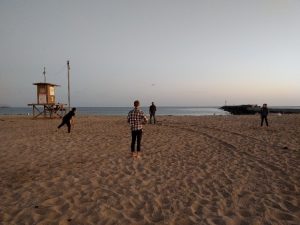Happy New Year everyone! It seems the fall has flown by. Here are some of the highlights for the Ultrafine Aerosol Group.
At the end of the summer we said farewell to our awesome summer research undergrads with a bonfire and dinner on the beach. During the summer, Irmak Sengur (senior, UCI Chemistry) worked with Mike to analyze particle samples collected during the North Atlantic Aerosols and Marine Ecosystems Study (NAAMES). Hannah Medina (sophomore, UCI Chemistry) oversaw the operation of our particle size distribution instrument, for which we will soon provide real-time data on our webpage. Justin Min (UC Riverside, B.S., Chemistry and Environmental Science), worked on some new instrument development projects for analyzing the composition of ultrafine aerosol particles.
We also welcomed a new visiting graduate student to the group. Xiaoxiao Li is a 3rd year PhD student from the research group of Prof. Jingkun Jiang at Tsinghua University in Beijing, China. Xiaoxiao is already making herself indispensable on some instrument development projects for measuring trace gases and nanoparticles. We will enjoy working with her over the coming year!
We closed out the year with some great papers, including the first to feature research that was initiated here at UCI (zot! zot! zot!). In this study we found that new particles that form in the atmosphere can do so high above-ground before such events are observed by ground-based instruments. Once formed, these particles can take up significant amounts of water and become more liquid-like, which can impact the role that these particles play in atmospheric chemistry and cloud formation processes.
- Vertically resolved concentration and liquid water content of atmospheric nanoparticles at the US DOE Southern Great Plains site. Chen, H.; Hodshire, A., L.; Ortega, J.; Greenberg, J.; McMurry, P., H.; Carlton, A., G.; Pierce, J., R.; Hanson, D., R.; and Smith, J., N. in press in Atmos. Chem. Phys.
A complete list of papers can be found on our web page. Here are some more recent highlights:
- Measurements from a temperate needleleaf forest in Colorado formed the basis for a comprehensive representation of gas- and particle-phase organics in a manuscript recently published in Nature Geoscience. This was the first study to construct a complete budget of atmospheric organic compounds, including emission, ageing, and deposition. Another highlight of this study was the observation that semivolatile and intermediate volatility organics comprise ~1/3 of the total organic carbon at this locale.
- The product of a workshop sponsored by the Department of Energy, a review of recent advances towards understanding the formation of atmospheric organic aerosol was published in Reviews of Geophysics. The UA group was part of the writing team for a section on the role of Highly Oxygenated Multifunctional Compounds (aka “HOMs”) in aerosol formation.
- While we are hard at work analyzing our data from the Green Ocean Amazon experiment (GoAmazon2014/5) in the Amazon Basin in Brazil, we have recently published an overview paper.
New research projects started in the fall, the result of recently funded proposals:
- DOE Atmospheric System Research Program, “Impacts of Phase State and Water Content on Secondary Organic Aerosol Formation and Partitioning,” with Manabu Shiraiwa, Sergey Nizkorodov, and Ann Marie Carlton (all from UCI! Yea team!)
- NSF Environmental Chemical Sciences Program, “Collaborative research: Applicability limits of aqueous pKa values for bulk and surface nanoparticle Processes,” with Kelley Barsanti and Bryan Wong (UC Riverside).
Have a wonderful 2018 everyone!


